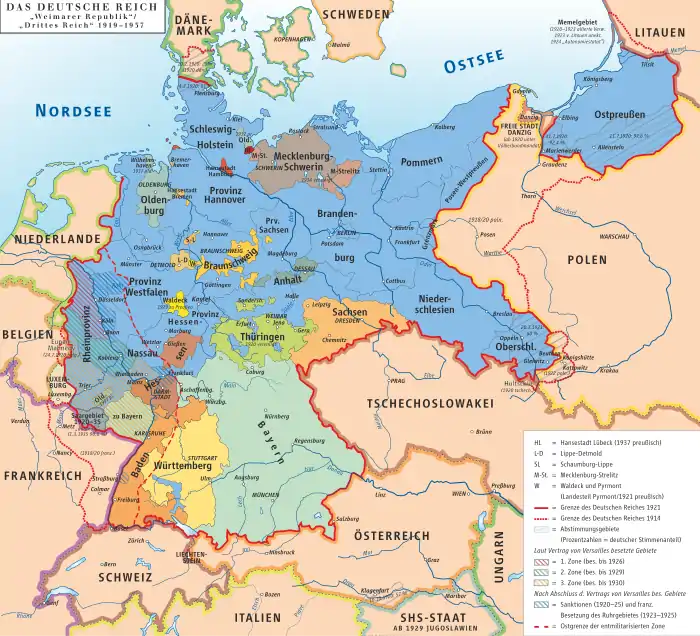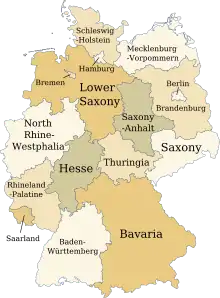History of Hamburg
The history of Hamburg begins with its foundation in the 9th century as a mission settlement to convert the Saxons. Since the Middle Ages, Hamburg was an important trading center in Europe. The convenient location of the port and its independence as a city and state for centuries strengthened this position.
Part of a series on the |
|---|
| History of Hamburg |
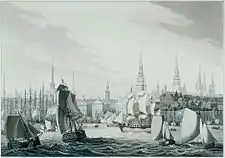 |
| by timeline |
| by other topic |
|
The city was member in the medieval Hanseatic trading league and a free imperial city of the Holy Roman Empire. From 1815 until 1866 Hamburg was an independent and sovereign state of the German Confederation, then the North German Confederation (1866–71), the German Empire (1871–1918) and during the period of the Weimar Republic (1918–33). In Nazi Germany Hamburg was a city-state and a Gau from 1934 until 1945. After the Second World War Hamburg was in the British Zone of Occupation and became a state in the western part of Germany in the Federal Republic of Germany (Since 1949).
Etymology
According to Ptolemy, the settlement's first name was Treva. A fortress there was named Hammaburg (burg means "fortress"). In Old High German. hamma means "angle" and hamme means "pastureland", but the meaning of hamma in this context is unknown. The angle might refer to a spit of land or to the curvature of a river. The language spoken might not have been Old High German, as Low Saxon was spoken there later. Other theories hold that the castle was named for the word of a surrounding vast forest, hammen.[1] Hamm as a place name occurs a number of times in Germany, but its meaning is equally uncertain. It could be related to "heim" and Hamburg could have been placed in the territory of the ancient Chamavi. However, a derivation of "home city" is perhaps too direct, as the city was named after the castle. Another theory is that Hamburg comes from ham which is Old Saxon for “(grassy) river bank” or “meadow/pasture (by a river) ”.
First steps until 1189 AD
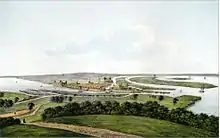
First settlers in the area would have been a hunting and gathering society in the late Upper Paleolithic and Neolithic. There are several archaeological documented records in the areas of Wellingsbüttel, Meiendorf and Rahlstedt from 20,000 to 8000 BC. In 4000 BC first permanent settlements are recorded in the area of Fischbeker Heide.[2] The culture of hunters is named Hamburg culture.[3]
In 808 AD a castle was ordered to be built by Emperor Charlemagne, as a defense against Slavic and Viking intrusions. Later Charlemagne's son Louis built this castle on the old trading path from Hedeby in the North to Magdeburg and Bardowick in 810. On 25 December 831 Ansgar was consecrated as the archbishop for the Hammaburg. Ansgar became later known as the Apostle of the North. Ebbo, Archbishop of Reims claimed to have built a baptistery in a small village in this area and this village was named after him Ebbodorp, Eppendorp or Eppendorf.[1] In 845 Vikings came up the River Elbe and destroyed Hamburg, at that time a town of around 500 inhabitants. Two years later, Hamburg was united with Bremen as the Bishopric of Hamburg-Bremen. In 880 Hamburg was destroyed again this time by Slavic and Danish soldiers. Pope Benedict V was deposed and carried off to Hamburg in 964. He died in 965 and was buried in the St. Mary's Cathedral.[4]
In 983, the town was destroyed by King Mstivoj of the Obodrites. In 1050 Hamburg consisted of four castles, the bishopric castle also known as Bischofsturm was built around 1037 by Bezelin. The Wiedenburg was built 1043 by Adalbert. The Alsterburg was built by Duke Bernard II of Saxony in 1045 and the new castle built in 1050. After further raids by the Obodrites in 1066 the bishop Adalbert permanently moved to Bremen.[4]
In 1188 Hamburg adopted the Lübeck law (Lübsches Recht), a code of rights superseded in some areas in 1900 by the civil code of Germany (Bürgerliches Gesetzbuch), although it is disputed if the law in Hamburg originated from an own law.
On the way 1189–1529
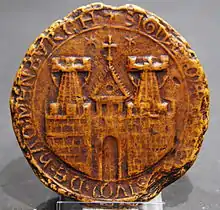
A charter in 1189 by Frederick I, Holy Roman Emperor granted Hamburg the status of an Imperial Free City and tax-free access up the Lower Elbe into the North Sea, the right to fish, to cut trees and the freedom of military service.[5] The charter was given orally for Hamburg's backing of Frederick's crusades, and in 1265 an in all probability forged letter was presented to or by the Rath of Hamburg.[6] In 1190 the bishop's old city and the count's new city created a noble council (Rath). Valdemar II of Denmark raided and occupied Hamburg in 1201 and in 1214 Frederick II, Holy Roman Emperor declined all claims of property northern of the river Elbe. Hamburg was controlled by Denmark. The Danish governor united the new and the old parts of Hamburg under one law, town hall and court. A series of Danish defeats culminating in the Battle of Bornhöved on 22 July 1227 cemented the loss of Denmark's northern German territories and liberated Hamburg also. Hamburg submitted to Adolf IV of Holstein.[7] From 1230 a new fortification was built. Its layout and names can be found in 2008, e.g. Millerntor-Stadion, named after the western city gate Mildradistor or Mildertor, and the park Planten un Blomen, build on the old fortification.[8]
In 1264 the senate of Hamburg enacted a law to protect the swans of the city. Hard punishments should be given if a swan was beaten to death, insulted, shot or eaten. A popular belief (omen) is that Hamburg will be free and hanseatic as long as swans are living on the Alster river.[9] On 5 August 1284 a great fire destroyed all but one residential house in Hamburg. The first description of civil, criminal and procedural law for a city in Germany in German language, the Ordeelbook (Ordeel: sentence) was written by the solicitor of the senate Jordan von Boitzenburg in 1270.[10][11] In 1350 the Black Death, one of the deadliest pandemics in human history, struck in Hamburg killing more than 6,000, half of the city's population.[10][12]
Hanseatic league
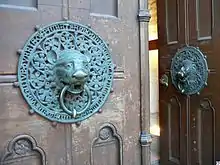
Two contracts with Lübeck in 1241 marks the origin and core of the powerful Hanseatic League of trading cities. The first contract stated that both cities would defend their freedom and their privileges together. The second contract stated that the road between the two cities will be secured against bandits and that deported émigrés would not find shelter in the other city. In 1264 the east–west route for commerce was cobbled in Hamburg. It was the third cobbled road in northern Europe and called Steinstraße, which is still the name of a street in Hamburg.[8]
On 8 November 1266 a contract between Henry III and Hamburg's traders allowed them to establish a hanse in London. This was the first time in history the word hanse was mentioned for the trading guild Hanseatic League.[13] In May 1368 a fleet of 37 ships and 2,000 armed men, including two cogs and 200 men from Hamburg, conquered Copenhagen and razed it to the ground. Hamburg's most important export article was beer. In 1377 a new currency, the Mark, was established by the Wendischer Münzverein (Wend currency association). The cities Hamburg, Lübeck, Luneburg, Wismar and Rostock formed this association. Three tonnes of beer cost one mark. At this time Hamburg's population was 14,000. Hamburg was the third–largest city in the Hanseatic League (after Lübeck and Cologne). On 21 October 1401 the pirate Klaus Störtebeker was executed in Hamburg, although pirates were often thrown overboard to drown or decapitated shortly after their capture.[14]
In 1433 Simon van Utrecht defeated the pirates and conquered Emden. Bremen started a war of capturing ships against Hamburg, Lübeck, Lüneburg and the Netherlands in 1438.[15]
First constitution
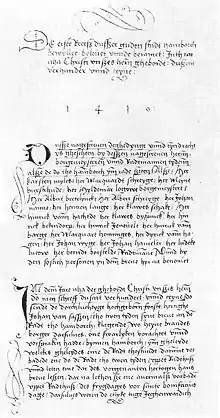
The first constitution of Hamburg was established on 10 August 1410. A civil commotion caused a compromise (German:Rezeß, literally meaning: withdrawal).
The citizen Hein Brandt has met the duke Johannes IV of Saxe-Lauenburg, who owed Brandt money. Brandt took the duke to task and insulted him. The duke complained to the senate. The senate cited Brandt and he confessed and was arrested. This caused an uproar and citizens formed a council. At this time the senate was formed by richest citizens, not elected and the senate did not need to give account for its decisions. The situation in Hamburg was unstable because in 1408 members of the senate of Lübeck had found asylum in Hamburg, after they were expelled by the citizens of Lübeck.
The formed council of the sixty (German: der Sechzigerrat) demanded to free Brandt and to enter into negotiations. The mayor Kersten Miles and the senate freed Brandt and agreed after four days of negotiations to a compromise of 20 points. Some of these points were:
- Article 1. No citizen, poor or rich, is to be arrested without a hearing at the senate or a court.
- Article 6. The senate is not allowed to begin a war without a hearing of the citizens.
- Article 10. The senate cannot grant safe conduct for a person who owes a citizen of Hamburg.
- Article 13. In case of disputes between the senate and the citizens, these disputes need to be corrected immediately and are not to be delayed by jurists.
- Article 15. Disloyal public servants need to be discharged.[16]
It is the considered as the first constitution of Hamburg.[17]
The Lutheran church law and its consequences
.jpg.webp)
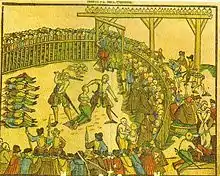
On 15 May 1529 the city embraced Lutheranism. The senate of Hamburg had asked Martin Luther to send his friend and colleague Johannes Bugenhagen to create a new church regularity. Bugenhagen's work created a state church for Hamburg. The service was held in Low German and the parishes elected their own pastors. There was no iconoclasm in Hamburg mostly because of Johannes Aepinus, the new pastor of St. Petri, who stated the statues of false gods and lying pictures needed to be removed from the churches instantly. He took them down and stored them, so that altarpieces by Meister Bertram and others survived, and are now in the city's museums. At the same time on 24 February, the long compromise (German: Langer Rezeß) reorganized the political system. The senate, now 24 aldermen, held the executive and judicial authority. But without the council of the citizens, no laws could be enacted. The councils were elected by the 4 parishes. The parishes were now also administrative divisions of the city.[18] In May 1531 the cathedral chapter closed the Catholic cathedral, it only reopened as Lutheran proto-cathedral in 1540.[19] Roman Catholics lost their citizenship and were challenged to leave the city, although remaining Catholics could practice their religion in the small chapels of the diplomatic missions of the Holy Roman Empire. Not until 1785 did the senate acknowledge a small community.[20]
In 1558 the Hamburg stock market was founded. In 1567 Hamburg asked a group of English traders to settle in the city. This was in conflict with the rules of the Hanseatic League, but Hamburg used the taxes to downsize the public debt. The cause of this debt was Hamburg's contribution to the Schmalkaldic War (1546–1552) between the Lutheran dukes and cities and the emperor.[21]
Modern History
17th and 18th centuries
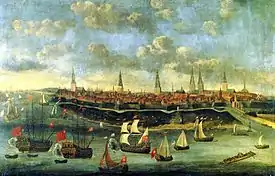
When the Senate commissioned Jan van Valckenborgh to build a second layer to the city's fortifications to protect against the Thirty Years War (1618–1648), Hamburg was also extended by the newly created "New Town" (Neustadt). Some of these street names still date from the grid system of roads he introduced.[22] In the late 1580s, the first Sephardi Jews arrived—fleeing from Portugal—and built a Portuguese Jewish community in Hamburg. In 1610, official lists of the senate counted about 100 Jewish families. Lutheran theologians preached against them, especially the "schools of Satan"—meaning the synagogues—and in 1611 the senate had to ask the Lutheran theological faculties of Jena and Frankfort for their opinions. The faculties attested to the senate that the Jews should be tolerated in the town as strangers. The safety in person were granted; however, several assaults, often triggered by Christian homilies, against individual Jews took place. The community was not to be allowed to practise its religion publicly, but small private praying rooms were overlooked. Not until 1660 could the first small synagogue be built.[23]
In 1712/13, the plague raged in Hamburg and Altona. The latter was burned down by a trespassing Swedish army (Altona was not part of Hamburg at the time); Sweden's adversaries retaliated by burning down Wolgast in Swedish Pomerania.[24]
In 1762 the city was briefly occupied by Danish forces who were trying to raise money to fight a coming war with Russia.[25]
19th century
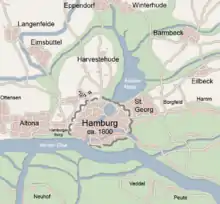
Briefly annexed by Napoleon I (1810–14), Hamburg was the capital of the department Bouches-de-l'Elbe, with Amandus Augustus Abendroth as the new mayor.[26] Hamburg suffered severely during the Continental Blockade and Napoleon's last campaign in Germany but managed to raise two forces to fight against him, the Hamburg Citizen Militia and Hanseatic Legion. The city was besieged for over a year by Allied forces (mostly Russian, Swedish and German). Russian forces under General Bennigsen finally freed the city in 1814. In addition to stimulating German nationalism, the war had a major impact in mobilizing a civic spirit in numerous volunteer activities. Many volunteer militias and civic associations were formed, and collaborated with churches, and the press to support local and state armies, patriotic wartime mobilization, humanitarian relief and postwar commemorative practices and rituals.[27]
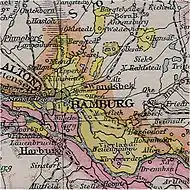
Hamburg was a member of the 39-state German Confederation from 1814 to 1866 and, as the other member-states, enjoyed full sovereignty.[28] After periodic political unrest, particularly in 1848, the self-ruling city-state adopted a democratic constitution in 1860 that provided for the election of the Senate, the governing body of the city-state, by adult taxpaying males. Other innovations were the separation of powers, the separation of Church and State, freedom of the press, of assembly and association. Hamburg became a member of the North German Confederation (1866–71), the German Empire (1871–1918), while in 1888 it was one of the last two states to join the German Customs Union (along with Bremen) and was to maintain its self-ruling status during the Weimar Republic (1919–33).
During the first half of the 19th century a patron goddess with Hamburg's Latin name Hammonia emerged,[29] mostly in romantic and poetic references, and although she has no mythology to call her own, Hammonia became the symbol of the city's spirit during this time.
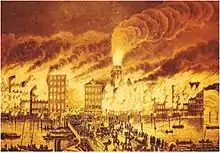
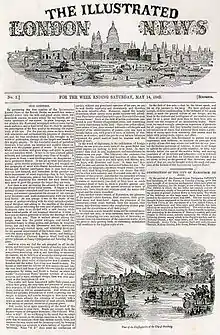
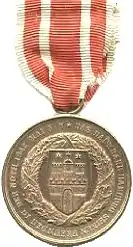
In 1842, about a third of the city was destroyed in the "Great Fire". This fire started on the night of 4 May 1842 and was extinguished on 8 May. It destroyed three churches, the town hall, and countless other buildings. It killed 51 people, and left an estimated 20,000 homeless. Reconstruction took more than 40 years. As part of the reconstruction, the first large modern sanitation system in Europe was built in Hamburg.[31]
.jpg.webp)
Hamburg experienced its fastest growth during the second half of the 19th century, when its population more than quadrupled to 800,000 as the growth of the city's Atlantic trade helped make it Europe's third-largest port. Construction of the port lead to the disappearance of several of the smaller of Hamburg's many rivers and channels, such as the Dradenau.
A major outbreak of cholera in 1892 was very badly handled by the city government, which still retained an unusual degree of independence for a German city at the time. About 8,600 died in the largest German epidemic of the late 19th century, and the last major cholera epidemic in an important city in the Western world. The Hamburg water supply from the Elbe did not meet modern standards, and the authorities long continued to deny there was an epidemic, or implement the new understanding of the germ theory of disease. The Imperial government used the scandal to greatly reduce the powers of the city authorities.[32]
20th century
With Albert Ballin as its director the Hamburg-America Line became the world's largest transatlantic shipping company around the start of the 20th century, and Hamburg was also home to shipping companies to South America, Africa, India and East Asia. Hamburg became a cosmopolitan metropolis based on worldwide trade. Hamburg was the port for most Germans and Eastern Europeans to leave for the New World and became home to trading communities from all over the world (like a small Chinatown in Altona, Hamburg).
In 1903, the world's first organised club for social and family nudism, Freilichtpark (Free-Light Park) was opened in Hamburg.[33] It was located on a lake formed by the Alster River in the southern part of the city, adjoining a bathing beach. After World War I Germany lost her colonies and Hamburg lost many of its trade routes.
German Revolution
After the November Revolution, the Workers' and Soldiers' Councils took the city administrations under their control. They agreed to hold a free, equal and secret-ballot election on March 16, 1919. There were 6 elections in total from 1919 to 1933. In the first election, SPD and DDP agreed to form a coalition. However, populist sentiments were rising after WWI and the Great Depression, and the relatively centrist SPD quickly lost grounds. In the last election, the NSDAP got 35% of the vote and the KPD got 15% of the vote. This paves the way for the subsequent Nazi ruling.[34]
The Communist movement in Hamburg led a short-lived "Sparticist" revolt that was quickly repressed in 1919.[35]
In Nazi Germany
After the takeover of power by the Nazi regime, administrative powers were significantly altered. The Gesetz über den Neuaufbau des Reiches (Law concerning the reconstruction of the Reich) (30 January 1934) abandoned the concept of a federal republic. The political institutions of the Länder were practically abolished altogether, passing all powers to the central government. The German constituent states were replaced in 1935 by regional districts (German: Gau) led by Nazi Party officials who obeyed the central government's orders. On 16 May 1933 Karl Kaufmann (1900–1969) was appointed as Reichsstatthalter (imperial governor or imperial lieutenant) in Hamburg. The Hamburg Senate had resigned in March 1933 and the Hamburg Parliament elected Carl Vincent Krogmann (NSDAP) as mayor.[36]
In 1938 the city boundaries were extended with the Greater Hamburg Act to incorporate Wandsbek, Harburg, Wilhelmsburg and Altona. On 1 April 1938 Constitution of Hamburg was suppressed through an Imperial Law (German: Reichsgesetz),[37] the Hamburg Senate was dissolved and the position of First Mayor of Hamburg abolished. Hamburg was named Hansestadt Hamburg.
During World War II Hamburg suffered a series of devastating air raids which killed 42,000 German civilians. British bombers dropped 23,000 tons of bombs, the Americans dropped 16,000 tons. As the bombings continued more and more people moved out. By May 1945 half a million people (35%) had fled.[38]
Through this, and the new zoning guidelines of the 1960s, the inner city lost much of its architectural past. From 1938 until 1945 a concentration camp was established in the Neuengamme quarter of Hamburg, the Neuengamme concentration camp,[39] some of the buildings have been preserved and as of 2008 serve as a memorial. From 1939 until 1945 more than 500,000 men, women and children[40] — including prisoners of war — were forced to work at more than 900 companies, living in more than 1,200 camps all over Hamburg. Some of these camps held only 7 inmates, others were known for more than 1,500 inmates.[41]
After the Second World War
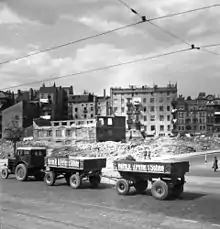
After the end of the Second World War until the end of the Besatzungsstatut Hamburg was a British-occupied from 1945 to 1949. Specially George Ayscough Armytage and Governor Henry V. Berry identified with the city and worked through the indirect rule, asking prospective Hamburg inhabitants to resume office in the administration.[42] Denazification and rebuilding of the society proceeded, e.g. in Hamburg were the important trials for war crimes (Hamburg Ravensbrück Trials) held at the Curio house in Rotherbaum quarter, and Radio Hamburg, a public broadcasting radio station, was established on 4 May 1945, even before the capitulation.
The Iron Curtain — only 50 kilometres (30 mi) east of Hamburg — separated the city from most of its hinterland and further reduced Hamburg's global trade. On 16 February 1962 a severe storm caused the Elbe to rise to an all-time high, inundating one fifth of Hamburg and killing more than 300 people.[43]
In the 2000s

After German reunification in 1990, and the accession of some Eastern European and Baltic States into the EU in 2004, Hamburg Harbour and Hamburg have ambitions for regaining their positions as the region's largest deep-sea port for container shipping and its major commercial and trading centre.
A group of radical Islamists that included students who eventually came to be key operatives in the 9/11 attacks, according to U.S. and German intelligence agencies, was called the Hamburg cell.[44]
On 7 and 8 July 2017, the G20 summit took place in Hamburg, accompanied by protests and riots.[45]
See also
- Postage stamps and postal history of Hamburg
- Timeline of Hamburg history (extended version)
Notes
- Verg, p. 8
- Verg, p. 11
- Tereberger, Thomas (2006), "From the First Humans to the Mesolithic Hunters in the Northern German Lowlands, Current Results and Trends" (PDF), Across the western Baltic, edited by: Keld Møller Hansen & Kristoffer Buck Pedersen, Sydsjællands Museums Publikationer Vol. 1, ISBN 87-983097-5-7, archived from the original (PDF) on 2008-09-11
- Verg, p.15
- Verg, p. 16
- Verg, p. 26
- Verg, p. 20
- Verg, p. 23
- Strothmann, Dierk (2008-06-14), Die Schwingen der Freiheit, Hamburger Abendblatt, retrieved 2008-09-01 (Wings of freedom) (in German)
- Verg, p. 25
- Clark, David S. (1987), "The Medieval Origins of Modern Legal Education: Between Church and State", The American Journal of Comparative Law, American Society of Comparative Law, 35 (4): 653–719, doi:10.2307/840129, JSTOR 840129
- Snell, Melissa (2006), The Great Mortality, Historymedren.about.com, retrieved 2009-04-19
- Verg, p. 30
- Verg, pp. 32–37
- Verg, p. 42
- Art. 1: Kein Bürger, arm oder reich, darf ohne Anhörung durch Rat oder Gericht verhaftet werden.
Art. 6: Es soll der Rat keinen Krieg anfangen, sondern darüber erst die Bürger fragen.
Art. 10: Der Rat darf niemendem freies Geleit zusichern, der Schulden bei Hamburger Bürgern hat.
Art. 13: Bei Streitigkeiten zwischen Rat und Bürgern sind diese ohne Verzug zu bereinigen und dürfen auch nicht durch Juristen verzögerd werden.
Art. 15: Untreue Bedienstete der Stadt sind zu entlassen.
Verg, p. 39 - Verg, p. 39
- Verg, pp. 45–46
- Jana Jürgs, Der Reformationsdiskurs der Stadt Hamburg: Ereignisabhängiges Textsortenaufkommen und textsortenabhängige Ereignisdarstellung der Reformation in Hamburg 1521-1531, Marburg an der Lahn: Tectum, 2003, p. 95. ISBN 3-8288-8590-X.
- Dennis S. Slaubaugh, '"Katholiken", Hamburg Lexikon, p. 266
- Verg, pp. 50–51
- History of the area Archived 2013-02-06 at the Wayback Machine, accessed 3 November 2012
- Michael Koglin (2009), Zu Fuß durch das jüdische Hamburg (in German), Hamburg: Die Hanse, pp. 149–150, ISBN 978-3-434-52630-8
- Winkle, Stefan (1983). "Die Pest in Hamburg. Epidemiologische und ätiologische Überlegungen während und nach der letzten Pestepidemie im Hamburger Raum 1712/13" (PDF). Hamburger Ärzteblatt. 2-3/1983 (Sonderdruck of part I&II first published in Jg. 37 pp. 51-57 and 82-87): 1–14. Archived from the original (PDF) on 2012-05-20.
- Dull, Jonathon R. The French Navy in the Seven Years War. University of Nebraska, 2005. p.220
- Abendroth, Amandus Augustus, Leipzig: Historische Commission bei der Königl. Akademie der Wissenschaften, 1875, retrieved 2008-09-30 from Elektronische Allgemeine Deutsche Biographie (in German)
- Katherine Aaslestad, "Cities and War: Modern Military Urbanism in Hamburg and Leipzig during the Napoleonic Era." German History 35.3 (2017): 381-402.
- Michael Hundt, "Souveränität", Hamburg Lexikon, pp. 439—440
- Heinrich Heine (1844), Deutschland. Ein Wintermärchen Caput XXIII, Hamburg: Hoffmann und Campe, retrieved 2008-09-30
- Gaedechens, Otto Christian; Gaedechens, C. F. (1850), Hamburgische Münzen und Medaillen (in German), Hamburg: J.A. Meissner
- Abellán 2017, p. 9.
- J. N. Hays, Epidemics and pandemics: their impacts on human history, pp. 321-326, ABC-CLIO, 2005, ISBN 1-85109-658-2, ISBN 978-1-85109-658-9, Internet Archive
- "Richard Ungewitter", Encyclopædia Britannica, Encyclopædia Britannica Online, 2008, retrieved 2008-10-01
- "Museum für Hamburgische Geschichte".
- J A S Grenville (2013). The Jews and Germans of Hamburg: The Destruction of a Civilization 1790-1945. Routledge. p. 33. ISBN 9781135745769.
- Verg, pp:161–163
- Impirial Law of the Constitution and Administration of Hamburg Reichsgesetz über die Verfassung und Verwaltung der Hansestadt Hamburg (in German), 1937-12-09, retrieved 2008-10-01
- Richard Overy, The Bombers and the Bombed: Allied Air War Over Europe 1940-1945 (2014) pp 301, 304
- No. 1034 in the official German list of concentration camps: Verzeichnis der Konzentrationslager und ihrer Außenkommandos gemäß § 42 Abs. 2 BEG (in German), Federal Ministry of Justice, 1967, archived from the original on 2007-06-10, retrieved 2008-09-20
- www.kz-gedenkstaette-neuengamme.de: Zwangsarbeiterlager in Hamburg (in German), KZ-Gedenkstätte Neuengamme (Camp memorial Neuengamme), archived from the original on 2007-08-23, retrieved 2008-10-04
- Zwangsarbeit in der Hamburger Kriegswirtschaft 1939-1945 (in German), Hamburg State Agency for Political Education, retrieved 2008-10-04
- Helmut Stubbe-da Luz, "Britische Besatzung", Hamburg Lexikon, pp. 85–86
- Sönnichsen, Uwe; Staritz, Hans-Werner (1978), Trutz, blanke Hans – Bilddokumentation der Flutkatastrophen 1962 und 1976 in Schleswig-Holstein und Hamburg (in German), Husum: Husum Druck- und Verlagsgesellschaft, ISBN 3-88042-055-6
- Al Qaeda aims at the American homeland, National Commission on Terrorist Attacks Upon the United States, retrieved 2008-10-01
- "G-20 Protests Grip Hamburg, and Dozens Are Hurt", New York Times, 2017-07-07, retrieved 2017-08-04
References
- Abellán, Javier (2017). Water supply and sanitation services in modern Europe: developments in 19th-20th centuries. 12th International Conference of the Spanish Association of Economic History. University of Salamanca.
- Comfort, Richard A. Revolutionary Hamburg: labor politics in the early Weimar Republic (Stanford University Press, 1966)
- Ferguson, Niall. Paper and iron: Hamburg business and German politics in the era of inflation, 1897-1927 (Cambridge University Press, 2002)
- Grenville, J A S (2013). The Jews and Germans of Hamburg: The Destruction of a Civilization 1790-1945. Routledge. ISBN 9781135745769.
- Lindemann, Mary. The Merchant Republics: Amsterdam, Antwerp, and Hamburg, 1648-1790 (Cambridge University Press, 2014) 356 pp.
- Lyth, Peter J. Inflation and the merchant economy: the Hamburg Mittelstand, 1914-1924 (Berg, 1990)
- Tschan, Francis Joseph, and Timothy Reuter. History of the archbishops of Hamburg-Bremen (Columbia University Press, 2002)
In German
- Verg, Erich; Verg, Martin (2007), Das Abenteuer das Hamburg heißt (in German) (4th ed.), Hamburg: Ellert&Richter, ISBN 978-3-8319-0137-1
- Kopitzsch, Franklin; Tilgner, Daniel, eds. (2005), Hamburg Lexikon (in German) (3 ed.), Ellert&Richter, ISBN 3-8319-0179-1 Missing or empty
|title=(help) - Poettering, Jorun, Handel, Nation und Religion. Kaufleute zwischen Hamburg und Portugal im 17. Jahrundert, Göttingen, Vandenhoeck & Ruprecht, 2013, ISBN 978-3-525-31022-9.
External links
| Wikimedia Commons has media related to History of Hamburg. |
- Official website. Retrieved 1 October 2008.
- Official website. More detailed German website. Retrieved 1 October 2008.
- History of Hamburg. (In German)
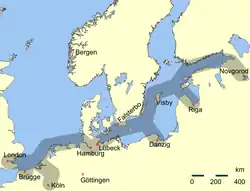
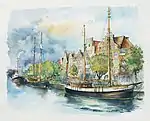

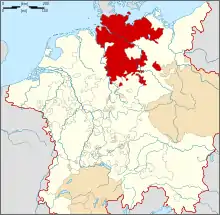
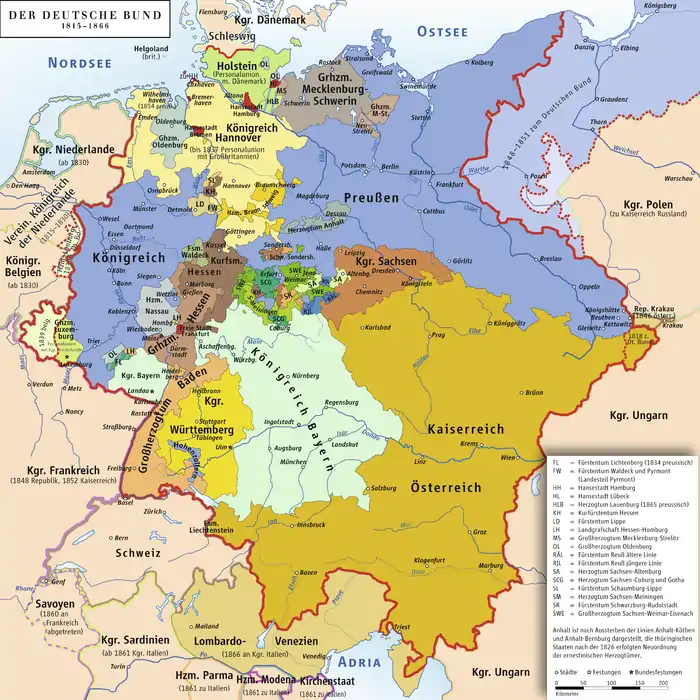
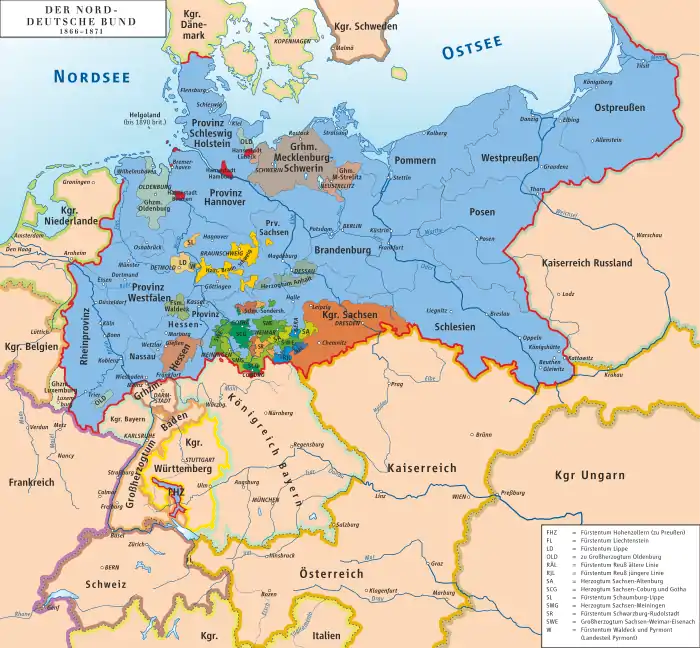
-en.png.webp)
